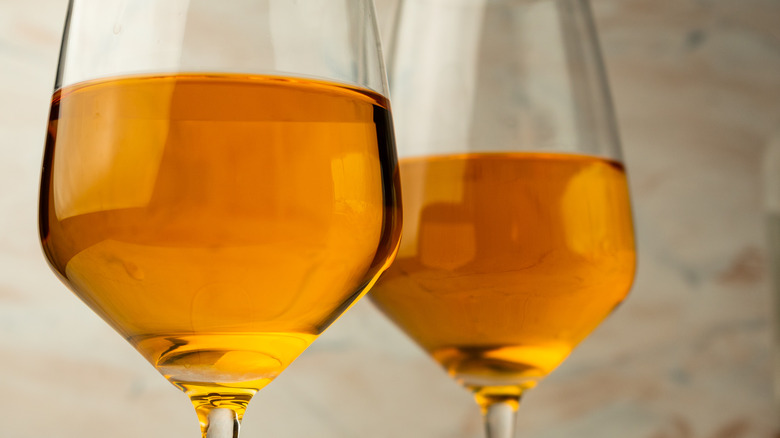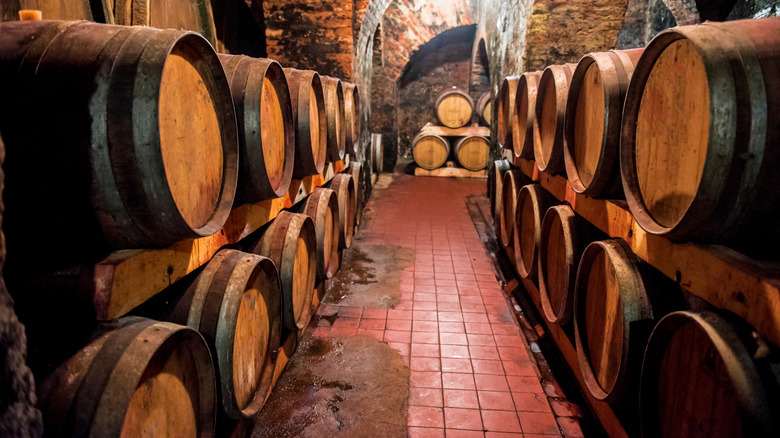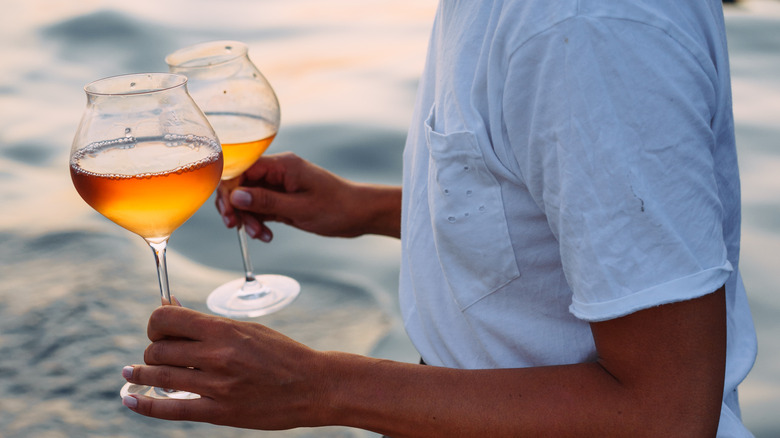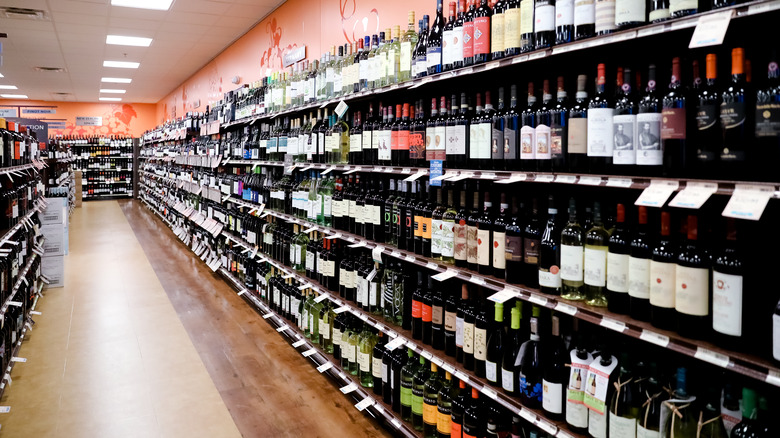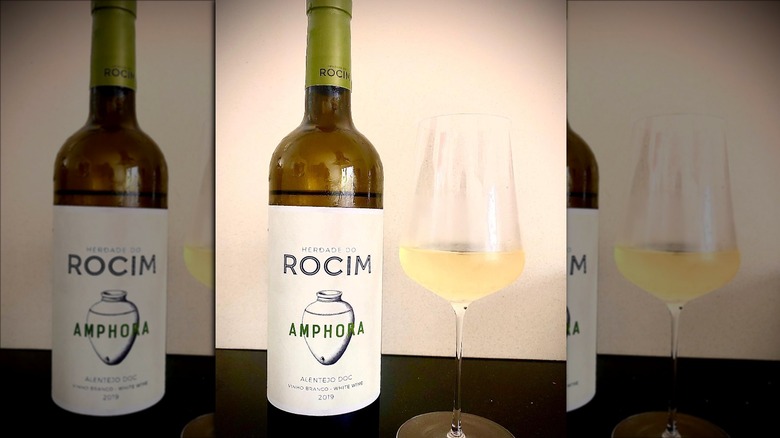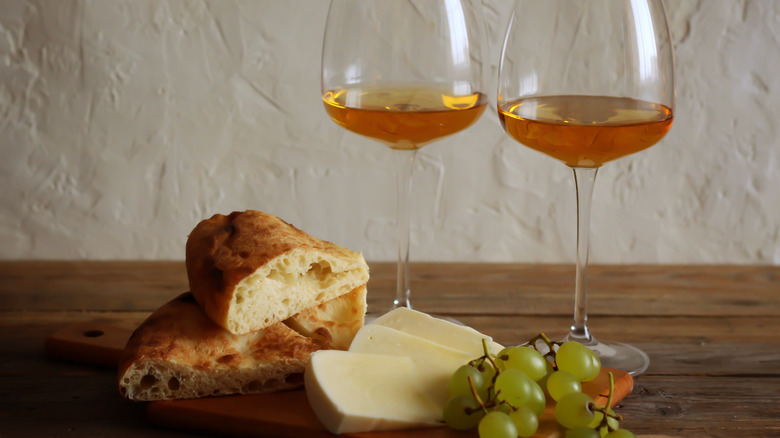What Is Orange Wine Really?
The world of wine is no more immune to shifting fads and trends than any other aspect of the food industry. Consider the vogue for white zinfandel in the '70s giving way to chardonnay in the '80s, merlot in the '90s, pinot noir in the '00s, and coming back around to another pink wine — rosé — in more recent years. One type of wine that is definitely trending, now, is one that many people love, others can't stand, but few seem to really understand: orange wine.
To anyone with a seriously misspent youth, that name may seem a trifle off-putting, conjuring up shameful memories of awful flavored fortified wines like MD 20/20 and Boone's Farm. The orange wine everyone's buzzing about these days, however, isn't made with any type of orange fruit or flavoring, just grapes. The "orange" in its name refers to its color, and the process by which it achieves this color also lends it its unique flavor.
How orange wine is made
Orange wine, according to Bon Appétit, is what is known as a "skin-contact' wine. What this means is, it is a white wine that is made in the style of a red wine: fermented with the skins being left on the grapes. Typical white wines have their skins removed before the fermentation process begins, but with an orange wine the skins and seeds are left in the fermenting juice for anywhere from a few hours to a few months and sometimes even up to a year or more.
Depending on the amount of time the skins remain in the juice, the color can range from yellow to bright orange to amber. In fact, the Italian term "ramato," which means "auburn," is applied to a Pinot Grigio made as a skin-contact orange wine. The natural fermentation that orange wine undergoes involves very little in the way of additives, with Wine Folly noting that some orange wines do not even require yeast.
What does orange wine taste like?
The longer the skins remain in the orange wine, the stronger its taste will be, as the skins add the tannin notes you'll find in a red wine to the natural acidity of the white wine. Wine Folly says that often they can be quite tart, similar to a sour fruit beer, while VinePair suggests that orange wine may remind you of a strong iced tea.
Patrick Cournot, a sommelier at NYC wine bar Ruffian, describes orange wines as "trendy and a little mischievous," and says they tend to "taste like a bolder, more savory version of [wines from] the same white grape." He also notes tea flavors (oolong, to be specific), along with stone fruits and a hint of honey without any of its sweetness. If you are new to orange wines, the darker-hued ones can be a bit too intense, so you might want to start off by drinking a lighter one.
Where to buy orange wine
Orange wine, as you may have guessed, is not the kind of thing you're likely to find on the shelves at a smaller, less-fancy liquor store or at your local grocery. What's more, to make matters even more confusing, Food & Wine reveals that orange wine cannot be sold under that label. Evidently, the Alcohol and Tobacco Tax & Trade Bureau has decreed that "orange wine" is a term best left to describe wine made from oranges (which actually does exist, according to WineMaker), so if you're shopping for orange wine of the non-citrus variety, you'll need to keep an eye out for such wine label terms as skin-fermented, skin contact, or amber wine as well as the Italian vino bianco macerato or Portuguese curtimenta.
While you should be able to find orange wines at major wine retailers as well as trendy wine bars and boutiques, Chatelaine suggests that the best place to buy them is (of course!) straight off the vine, or at least from the wineries that produce them. They do go on to say that the majority of these wineries tend to be in Eastern Europe and Italy, but note that there are several Canadian wineries making the stuff, while California Winery Advisor adds that both Napa Valley and Long Island wineries produce them in the U.S.
What are some orange wines to look for?
If you want to try orange wines, or you have tried them and like them but are looking for new varieties to check out, Food & Wine lists a number of their favorites. At the lower end of the price spectrum is a $19 bottle of 2019 Herdade do Rocim Amphora Branco from Portugal, a wine they describe as fruity, a little earthy, but without too much tannin flavor. The 2019 Deovlet Wines Pinot Grigio Ramato "This Time Tomorrow" is a California wine that they say is made in an old Venetian style and is smooth-tasting with hints of redcurrant and rhubarb. It retails for $35 a bottle.
Bon Appétit also has a few recommendations of their own, including an orange wine for people who have tried it and not liked it: Clot de l'Origine "l'Original" White Blend 2015, selling for $23. They describe it as very "approachable," (along with a bunch of flowery imagery involving Pinterest bridal boards or something) and suggest it as a great starter skin contact wine. If you prefer a more aggressively orangey orange wine, they suggest La Stoppa "Ageno" Blend 2012 at $40 a bottle. Evidently, its tannins are pretty in-your-face, and they did use the words "leather, "sweat," and "fresh asphalt" to describe the flavor, so if that combo (plus some fruity notes) sounds appealing, this may be your wine.
What foods does orange wine pair with?
Orange wine, at least as we've been describing it, might sound like something that would be a bit challenging to serve with food. While California Wine Advisor admits that orange wine does not play nicely with more delicate flavors, it stands up nicely to bold flavors like peppery dishes or curries and is a good match for Moroccan and Ethiopian cuisine. Wine Folly echoes this, calling orange wine a great match with injera, and adding that it goes well with fermented foods such as the Korean dish kimchi and the Japanese natto (a fermented soy bean preparation, known to have grossed out Adam Richman).
Perhaps the best pairing for orange wine isn't one specific food, though, but a whole buffet. NYC sommelier Patrick Cournot told VinePair that in Asia Minor, the Balkans, and the Caucuses, "individual dishes are rarely paired with wines. Instead, a spread of dishes are served at the same time, and multiple bottles will be placed in the middle of the table." In his opinion, "These [orange] wines can handle this wide range of flavors well."
